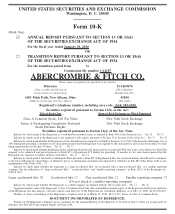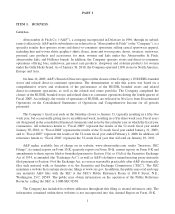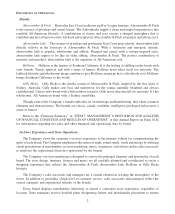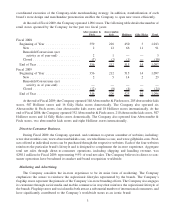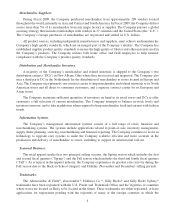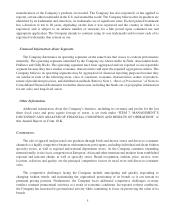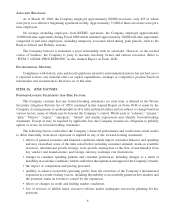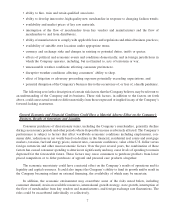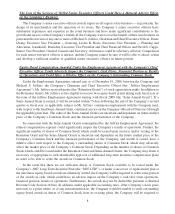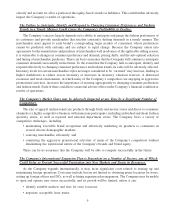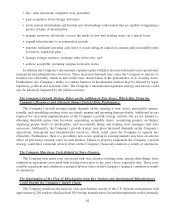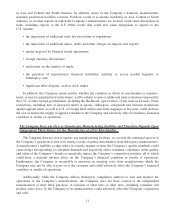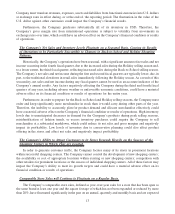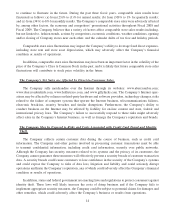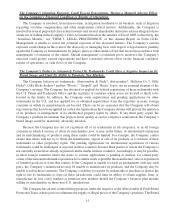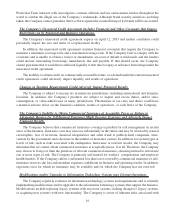Abercrombie & Fitch 2009 Annual Report Download - page 10
Download and view the complete annual report
Please find page 10 of the 2009 Abercrombie & Fitch annual report below. You can navigate through the pages in the report by either clicking on the pages listed below, or by using the keyword search tool below to find specific information within the annual report.
classify and account for all or a portion of the equity-based awards as liabilities. This could further adversely
impact the Company’s results of operations.
The Failure to Anticipate, Identify and Respond to Changing Consumer Preferences and Fashion
Trends in a Timely Manner Could Cause the Company’s Profitability to Decline.
The Company’s success largely depends on its ability to anticipate and gauge the fashion preferences of
its customers and provide merchandise that satisfies constantly shifting demands in a timely manner. The
merchandise must appeal to each brand’s corresponding target market of consumers whose preferences
cannot be predicted with certainty and are subject to rapid change. Because the Company enters into
agreements for the manufacture and purchase of merchandise well in advance of the applicable selling season,
it is vulnerable to changes in consumer preference and demand, pricing shifts, and the sub-optimal selection
and timing of merchandise purchases. There can be no assurance that the Company will continue to anticipate
consumer demands successfully in the future. To the extent that the Company fails to anticipate, identify and
respond effectively to changing consumer preferences and fashion trends, its sales will be adversely affected.
Inventory levels for certain merchandise styles no longer considered to be “on trend” may increase, leading to
higher markdowns to reduce excess inventory or increases in inventory valuation reserves. A distressed
economic and retail environment, in which many of the Company’s competitors are engaging in aggressive
promotional activities, increases the importance of reacting appropriately to changing consumer preferences
and fashion trends. Each of these could have a material adverse effect on the Company’s financial condition or
results of operations.
The Company’s Market Share may be Adversely Impacted at any Time by a Significant Number of
Competitors.
The sale of apparel and personal care products through brick-and-mortar stores and direct-to-consumer
channels is a highly competitive business with numerous participants, including individual and chain fashion
specialty stores, as well as regional and national department stores. The Company faces a variety of
competitive challenges, including:
• maintaining favorable brand recognition and effectively marketing its products to consumers in
several diverse demographic markets;
• sourcing merchandise efficiently; and
• countering the aggressive promotional activities of many of the Company’s competitors without
diminishing the aspirational nature of the Company’s brands and brand equity.
There can be no assurance that the Company will be able to compete successfully in the future.
The Company’s International Expansion Plan is Dependent on a Number of Factors, any of Which
Could Delay or Prevent Successful Penetration into New Markets and Strain its Resources.
As the Company expands internationally, it may incur significant costs related to starting up and
maintaining foreign operations. Costs may include, but are not limited to, obtaining prime locations for stores,
setting up foreign offices and DCs, as well as hiring experienced management. The Company may be unable
to open and operate new stores successfully, and its growth will be limited, unless it can:
• identify suitable markets and sites for store locations;
• negotiate acceptable lease terms;
9

